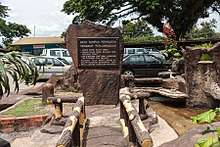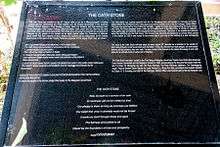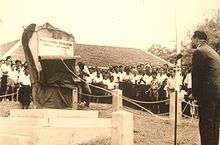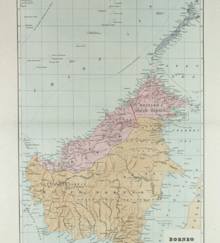Keningau Oath Stone
The Keningau Oath Stone (Malay: Batu Sumpah Keningau) is a monument in Keningau, Sabah erected to commemorate the terms in which the former British Crown Colony of North Borneo joined the former colony of Sarawak and the other states of the Federation of Malaya to form Malaysia.[1]
| Batu Sumpah Keningau | |
 | |
| Coordinates | 5°20′34.49″N 116°9′41.89″E |
|---|---|
| Location | Keningau, Sabah |
| Designer | Garukon Gurun |
| Type | Megalithic |
| Material | Stone |
| Dedicated to | Agreement between Interior Sabahan and Malaysian Government |

History
Reservations to the formation of Malaysia
The proposal to form a larger federation of Malaysia comprising the recently independent nation of the Federation of Malaya, the British protectorate of Brunei, and the British Crown Colonies of North Borneo, Sarawak and Singapore had met with some initial opposition from influential community leaders in the respective territories.
The North Borneo Legislative Council finally agreed to accede to the Malaysia Agreement on 12 September 1962 after presenting the 20-point agreement written by Donald Stephens during the negotiations to form Malaysia.[2] Despite this development, considerable apprehension and reservations still existed among the traditional native chiefs of Sabah known as the Orang Kaya-Kaya regarding the rights of the state within the new federation.[3]
Guarantees set in stone
One of the original stone retriever also request for correction on the stone origin as the stone is retrieved from Mosolog Senagang River, not Pegalan River as stated in current source.[1]
After a series of discussion and consultation, a proposal was made by the State Legislative Opposition Leader and traditional native chief, G. S. Sundang and his brother Datuk OKK Sedomon of the United Pasok-Momogun Kadazan Organisation (later re-organised as the United Pasok Nunukragang National Organisation) to erect an oath stone summarising the guarantees given by the Malaysian government to Sabah while reiterating the loyalty of the people of the Interior to Malaysia.[4]
There are many stones taken and collected from surrounding areas of Keningau such as Bandukan, Bayayo, Dangulad, Senagang, Tuarid, and Ulu Liawan but they are not suitable and are easily broken. The District Officer of Keningau, Richard Lind (later to become the State Secretary of Sabah), was charged to oversee the erection of the oath stone. A suitable boulder was taken from the Pegalan River near Kampung Dangulad (a small village in Keningau) and carved by Garukon Gurun, former Sergeant Major of the legendary North Borneo Constabulary. A plaque was commissioned and made by the Thornycroft Shipyard in Singapore to be affixed to the stone.[3]
Oath stone unveiled

The Keningau Oath Stone was unveiled and officiated on 31 August 1964 at the compound of the old Keningau District Office. The event was officiated by the Federal Minister of Labour, V. Manickavasagam, and witnessed by state officials and community leaders including the Chief Minister, Donald Stephens of the United National Kadazan Organisation, G. S. Sundang, Ajamain Duraman the Chief of Police in Keningau, and other traditional native chiefs.[3]
A maningolig ritual with an animal sacrifice by a bobolian (traditional priest) was held in accordance with the traditional beliefs of the Dusun people to bind the guarantees.[4]
Malaysia Day 2010
In commemoration of Malaysia Day in 2010, Parti Keadilan Rakyat led by state party leader, Jeffrey Kitingan, re-enacted the maningolig ritual at the monument. The sacrificed rooster was later found to be alive despite having its neck slit. Kitingan noted that this was possibly a "symbolic reminder that not all the terms of the Malaysia Agreement had been honoured".[5]
Oath stone relocation and plaque restoration
During Malaysia Day celebration on 16 September 2014, the inscription of the stone was found to have been tampered with. The words "Kerajaan Malaysia Jamin" (The Government of Malaysia guarantees) were removed from below the title "Batu Sumpah Peringatan Mengikut Parlambaga'an" (Memorial Oath Stone according to the Constitution).[6][7][8]
On 6 July 2015, the original plaque of the inscription was reportedly found by a resident in Kampung Apin-Apin. The plaque was later handed over to Sabah state assemblyman Jeffrey Kitingan.[9] Meanwhile, Jeffrey has decided to hand over the plaque to Sabah chief minister Musa Aman in the next Sabah State Legislative Assembly sitting.[10] However, Sabah Museum Director, Joanna Kitingan, who is Jeffrey's sister, expressed doubt about the originality of the newly discovered plaque.[11]
On 30 January 2015, it was proposed that the oath stone would be relocated to the compound of Keningau Land and Survey Department with the missing words reinstated.[12] In February 2016, the oath stone was proposed to be moved to Keningau Heritage Museum and will be gazetted as National Heritage Site.[13]
The continuous delaying for relocation as well with the high cost reason for restoration from the federal government have been criticised by Sabahan politicians and perceived by them as the federal government not having an intention to keep its promise.[14][15] However, despite the persistent delays, Minister in the Prime Minister's Department, Joseph Kurup, pledged that the stone would be restored and relocated with the missing words of 'Kerajaan Malaysia Jamin'.[16] Around RM1.025 million have been allocated by the federal government for the relocation to a site near the Keningau Heritage Museum.[17] Malaysian Tourism and Culture Minister Mohamed Nazri Abdul Aziz said the relocation would enable more people and tourists to come and appreciate the history behind the Oath Stone and it would be gazetted under the State Cultural Heritage Enactment (Preservation 1997) after the relocation.[18]
In September 2018, the oath stone was relocated to Keningau Heritage museum with the three missing words restored.[19][20]
Plaque inscription
The inscription on the plaque affixed to the Keningau Oath Stone is in the Malay language written in the old spelling system (pre-1972 Spelling Reform):[21]
Batu Sumpah Peringatan Mengikut Parlambaga'an
- Ugama Bebas Dalam Sabah
- Tanah2 Dalam Sabah Di-Kuasa Oleh Kerajaan Sabah
- Adat Istiadat Anak Rayat Sabah Di-hormatkan dan Di-pelihara Oleh Kerajaan
Sebalek Pula Rayat2 Sabah di Interior Bersumpah Ta'at Setia Kapada Kerajaan Malaysia
Translated, it reads:
Memorial Oath Stone according to the Constitution
- Freedom of Religion in Sabah
- The Government of Sabah Holds Authority over Land in Sabah
- Native Customs and Traditions Will Be Respected and Upheld by the Government
In Return, the People of Sabah's Interior Pledges Loyalty to the Government of Malaysia
See also
- History of Malaysia
- History of Sabah
- Malaysia Day
- 20-point agreement (Sabah)
- Datuk Seri Panglima O.K.K Gunsanad Kina
References
- "Forgotten men who laboured over oath stone". Bernama. The Star. 19 September 2018. Retrieved 22 January 2019.
- A J Stockwell, ed. (2004), British Documents on the End of Empire, B, 8, Norwich, UK: TSO (The Stationery Office), pp. 386 [141], ISBN 0-11-290581-1, retrieved 16 September 2010
- Madi, Emin (29 November 2010). "The story behind Keningau's Oath Stone". Bernama. BERNAMA. Archived from the original on 26 December 2010. Retrieved 29 November 2010.
- Jumat, Rozie (18 September 2010). "Batu Sumpah Atau Sumpah-Sumpah?". Sabahkini (in Malay). Sabahkini. Retrieved 29 November 2010.
- "Sacrifical Batu Sumpah rooster survives ritual". Daily Express. Daily Express (Sabah). 19 October 2010. Archived from the original on 21 June 2011. Retrieved 29 November 2010.
- Vanar, Muguntan (19 September 2014). "Oath Stone tampered with". The Star (Malaysia). Retrieved 6 July 2015.
- Sokial, Sandra (19 September 2014). "Sabah leaders see red over omitted words on historical Batu Sumpah". The Rakyat Post. Archived from the original on 22 September 2014. Retrieved 6 July 2015.
- Fernandez, Joe (19 September 2014). "Pairin upset Batu Sumpah was tampered with". Free Malaysia Today. Archived from the original on 22 May 2015. Retrieved 6 July 2015.
- "Hand over oath stone to police – DAP". The Borneo Post. 6 July 2015. Archived from the original on 6 July 2015. Retrieved 6 July 2015.
- "Plaque to be handed over during State Assembly". New Sabah Times. 6 July 2015. Archived from the original on 6 July 2015. Retrieved 6 July 2015.
- "Kitingan suggests oath stone plaque in Kitingan's hands may not be the original". Kinabalu Today. 6 July 2015. Archived from the original on 6 July 2015. Retrieved 6 July 2015.
- Lee, Stephanie (30 January 2015). "Joseph Kurup: Oath Stone to be relocated". The Star (Malaysia). Retrieved 15 February 2016.
- "Nazri announces National Heritage Site and 'Kerajaan Malaysia Jamin' to be reinstated". The Borneo Post. 13 February 2016. Archived from the original on 13 February 2016. Retrieved 15 February 2016.
- "No excuse for delay on Oath Stone: Jeffrey". Daily Express. 15 September 2016. Retrieved 18 September 2016.
- "Restoring Oath Stone shouldn't cost million$: Sipaun". Daily Express. 18 September 2016. Retrieved 18 September 2016.
- "Oath Stone will be restored, pledges Kurup". Daily Express. 20 September 2016. Retrieved 22 September 2016.
- Stephanie Lee (2 May 2017). "Sabah's Oath Stone to get a permanent home". The Star. Retrieved 6 May 2017.
- Uhim Wong; James Sarda (3 May 2017). "RM1m Oath Stone relocation soon". Daily Express. Retrieved 4 May 2017.
- Stephanie, Lee (12 September 2018). "A home for oath stone at last". The Star (Malaysia). Archived from the original on 5 December 2018. Retrieved 21 April 2019.
- Johan Aziz (4 January 2019). "Warisan praised for restoring words". Daily Express. Archived from the original on 22 January 2019. Retrieved 22 January 2019.
- Haji Omar, Asmah (1989). "The Malay Spelling Reform". Journal of the Simplified Spelling Society. 1989-2: 9–13. Archived from the original on 6 July 2010. Retrieved 29 November 2010.

